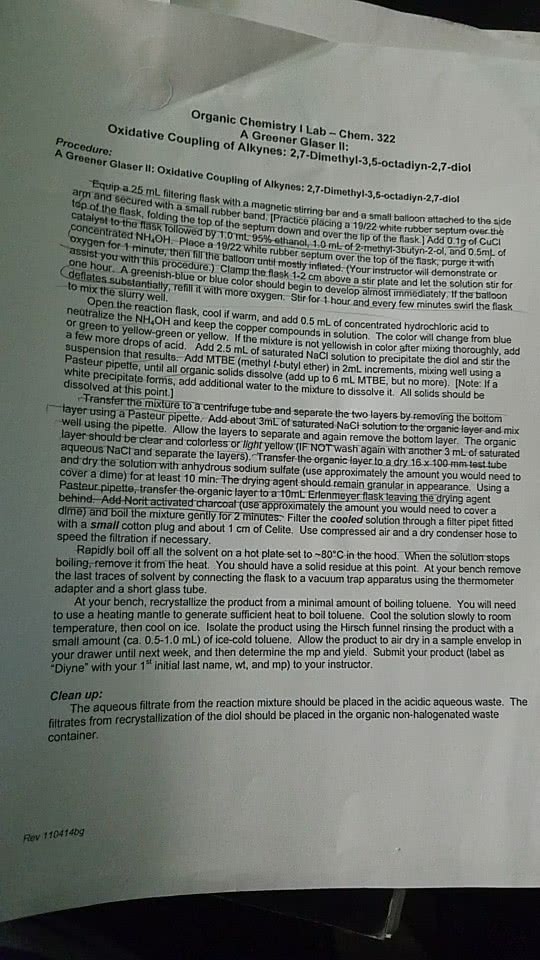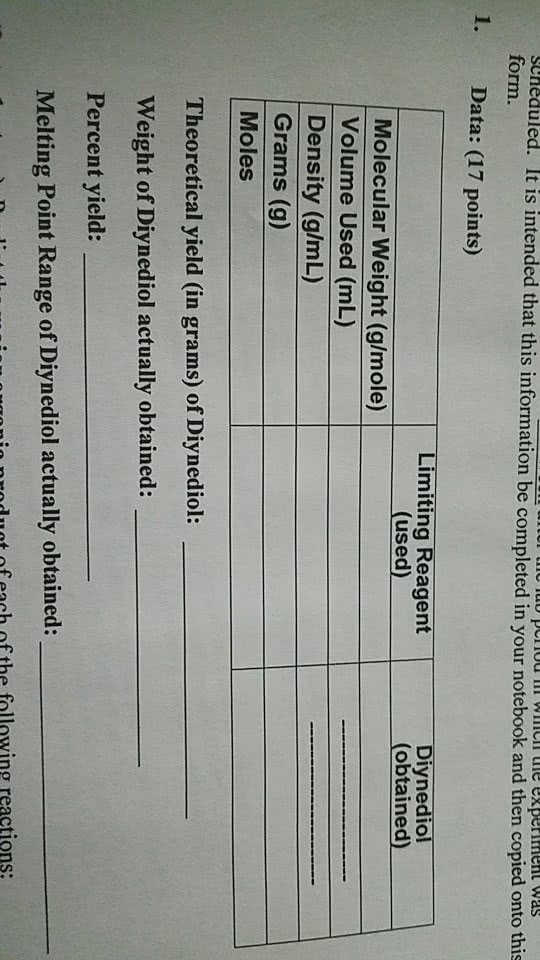CHEM 156 Study Guide - Final Guide: Dynamic Light Scattering, Magnetic Stirrer, Quantum Dot

Lab 1: Sol-gel Synthesis
Objective:
synthesis of small and large nanoparticles using stober synthesis and bulk silica sol-gel synthesis using both base and
acid as the catalyst.
Experimental Procedures:
Stober Synthesis of Nanoparticles:
1. Mix 17 mL EtOH and 7.5 mL NH3 into 12 DR vial and stir for 1 minute with magnetic stir bar
a. 3.0 M NH3 for larger nanoparticles and 1.0 NH3 for smaller nanoparticles
b. Solution appeared clear and transparent
2. Add 0.5 mL TEOS and stir at room temperature for 2 hours
a. Solution appeared clear and transparent at first
b. Solution with 3.0 M NH3 became cloudy faster (few minutes) than solution with 1.0 M NH3 (few more
minutes) during stirring
3. Disperse suspension in water and measure size of nanoparticles using dynamic light scattering
Base Catalyzed Bulk Silica Sol-gel Synthesis:
1. Mix 5 mL ethanol and 7 mL 1M NH3 into 12 DR vial and stir for 3 minutes at 60 degrees C with stir bar
a. Solution appeared clear and transparent
2. Add 5 mL TEOS and continue heating and stirring for 20 to 30 minutes with the vial capped
a. 2 layers formed; top slightly cloudier than the bottom
b. Turned cloudy in a few mins, solution became gel in about 25 mins
3. Observe any changes and results; obtain data for surface area
a. Gel height in vial: 3.2 cm; gel radius in vial: 1.3 cm; surface area: 36.76 cm^2
2-Step Acid Catalyzed Bulk Silica Sol-gel Synthesis:
1. Mix 14 mL TEOS and 15 mL ethanol into 100 mL round bottom flask with and stir with magnetic stir bar
a. Solution appeared clear and transparent
2. Add 18 mL distilled water and 0.25 mL 6M HCl solution under constant stirring with reflux condenser and
continue stirring for 1 hour at 60 degrees C.
a. 2 layers formed, top layer slightly cloudier than bottom layer
b. Single layer after few mins of mixing, clear and transparent solution
3. Pour solution into 20 mL sample vials and let cool to room temperature
a. Clear and transparent solution
4. Swirl sol in vial and squeeze 0.75 mL of 1M NH3 in the bottle; continue swirling until solution gels; seal bottle
a. Solution became gel in less than a minute; only bottom half became gel (slightly cloudy) while the top
half remained clear and transparent liquid; as time passed, all of the contents became gel
5. Obtain data for surface area
a. Gel height in vial: 2.7 cm; gel radius in vial: 1.3 cm; surface area: 32.67 cm^2

Lab 2: Synthesis and Optical Properties of CdSe Quantum Dot Nanocrystals
Objective:
CdSe quantum dot nanocrystals are synthesized from CdO and elemental Se. Kinetic growth method is used upon
synthesizing. Absorption and emission spectrum of the nanocrystals are taken to analyse the structure-property
relationship of the CdSe quantum dots.
Experimental Procedures:
1. Selenium stock solution preparation:
a. mix 30 mg Se, 5 mL 1-octadecene, and 0.4 mL trioctylphosphine in 10 mL round bottom flask
i. Se appearance (29 mg): black powder; 1-octadecene appearance: clear and colorless liquid;
trioctylphosphine appearance: clear and colorless liquid
ii. Solution was blackish grey when Se and 1-octadecene was mixed together, but gradually turned
clear and colorless once trioctylphosphine was added
b. warm slightly to speed dissolution of Se if necessary (30 to 50 degrees C for 20-30 mins), then store at
room temperature
i. Stirred for about 20 mins
2. Preparation of Cd precursor:
a. Heat mixture of 13 mg CdO, 0.6 mL oleic acid, and 10 mL octadecene in 25 mL round bottom flask with
sand bath to 225 degrees C
i. CdO appearance (13 mg): dark brownish red powder; oleic acid appearance: clear and colorless
liquid
b. Add 1 mL room temperature selenium solution
i. Solution immediately began to turn into orange color
c. Obtain ten 1 mL samples until the solution is deep red
i. Solution did not turn deep red; final color was dark orange
3. Measurement:
a. Label approximate time quenched after Se precursor injection and color under ambient light and UV
light for each sample
b. Collect absorbance and emission spectrum for each sample – sample dilution (1:2 QD solution :
octadecene, octadecene as background sample, record absorbance and emission peak wavelengths)
Sample
Number
Reaction
time -
sample
taken out
(min:sec)
Color (under
ambient
light)
Color
(from UV
excitation)
Max Absorption
wavelength
(nm)
Emission
wavelengt
h (nm)
1
0.22
Yellow
Neon
green
380.6
529
2
0.52
Light orange
Neon
green
380.6
532.2
3
1:02
Light orange
Neon
green
382.3
535.4
4
1:12
Orange
Neon
green
380.6
535.4
5
1:25
Orange
Neon
green
384
532.2
Document Summary
Lab 1: sol-gel synthesis synthesis of small and large nanoparticles using stober synthesis and bulk silica sol-gel synthesis using both base and acid as the catalyst. Lab 2: synthesis and optical properties of cdse quantum dot nanocrystals. Cdse quantum dot nanocrystals are synthesized from cdo and elemental se. Absorption and emission spectrum of the nanocrystals are taken to analyse the structure-property relationship of the cdse quantum dots. Pmma (poly(methyl methacrylate)) is synthesized by conventional free radical polymerization and living free radical polymerization. Gel permeation chromatography is used to analyze the molecular weight and molecular weight distribution of the polymers. Differential scanning caloimetry and thermal gravometric analysis are used to analyze the thermal properties of the polymers. Nylon 6. 6 is synthesized from hexamethylenediamine and adipoyl chloride in the form of nylon rope. Synthesis of polylactide (pla) and polynorbornene using ring opening polymerization technique and analysis of molecular weight and distribution using gel permeation chromatography (gpc), hnmr, and maldi-tof ms data.


